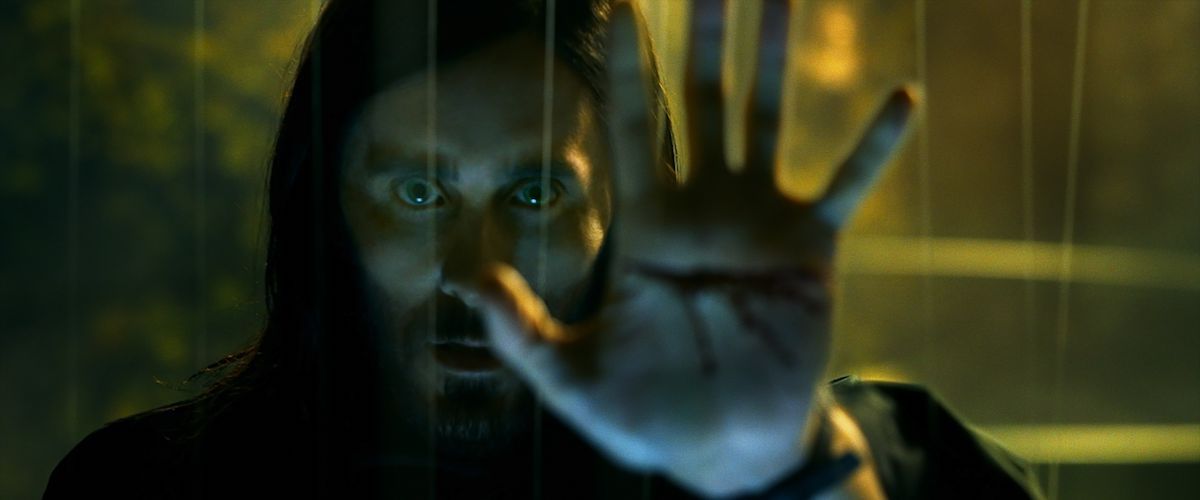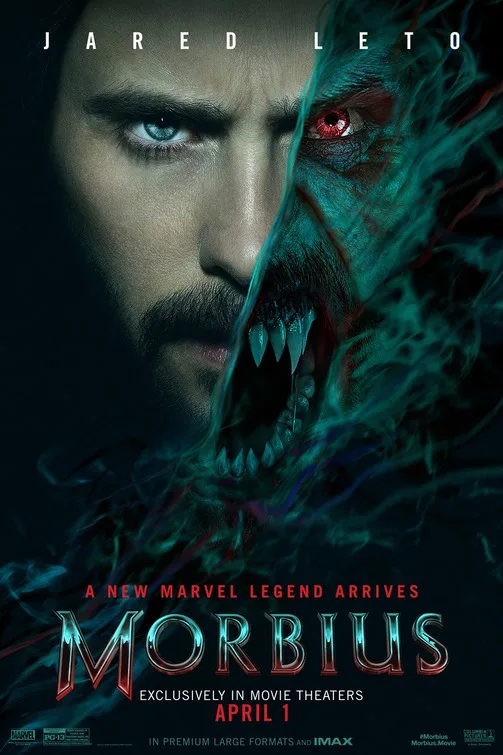Dr. Michael Morbius (Jared Leto), the title character of Columbia Pictures’ MCU-adjacent semi-horror movie “Morbius,” is a “living vampire.” What, you might be thinking, does that mean? Did the good doctor become a vampire without having to die first? Why, yes—he fused his DNA with vampire bat DNA in an attempt to cure the rare, fatal blood disease that’s been plaguing him since childhood. (What disease, you ask? You sweet, innocent child.) The fusion gave him super speed, super strength, echolocation abilities, and an appetite for blood that’s only partially sated by the artificial substitute for which Morbius rejects a Nobel Prize at the beginning of the film. (Why? Again, you’re asking too many questions.) In short, he’s a science vampire. (So, like if Batman was a doctor, then? Wrong universe, but close.)
So that means the usual rules of vampirism don’t apply, right? Yes and no. Loxias Crown (Matt Smith) Morbius’ best friend turned greatest adversary, does turn himself into a vampire using Morbius’ formula. But we don’t know if he died in the process. That sequence is left off screen, for reasons presumably tied to the many reshoots and delays that hampered “Morbius” on its journey to the big screen. And other characters die and come back to life after tasting Morbius’ blood, a supernatural transformation that doesn’t involve—as Morbius himself puts it at one point—”science stuff” at all. In short, the nature of Morbius’ affliction is messy and contradictory and not worth thinking about for more than a few seconds, a quality that extends throughout Daniel Espinosa’s misbegotten superhero/horror hybrid.
All the greatest metaphorical hits are present in Matt Sazama and Burk Sharpless’ script, as well as in Leto’s performance: Vampirism as illness? Check. Vampirism as addiction? Yup. Don’t ask for much in terms of actually developing these themes, however, as the film’s approach is to point and yell, “look over there!” whenever things get complicated. A superhero whose murders are the direct result of his attempts to help people presents a complex moral dilemma. But you wouldn’t know it from this film, which takes any intriguing elements of its title character’s story and flattens them into clichéd grandstanding about the obligation of the privileged few to protect the unsuspecting many.
The basic thrust of the plot is that Morbius—a celebrity scientist whose lab is funded by Crown’s family fortune—is conducting experiments ethically questionable enough that all involved think it best to pursue them on international waters. That’s no problem, given Crown’s vast wealth. But the aftermath of the experiment’s first human trial leaves eight sailors dead, and soon their bodies are discovered on a ghost ship much like the one that harbors Count Dracula at the beginning of Bram Stoker’s novel. (That’s not “Morbius’” only reference to other, more coherent vampire narratives: The ship is named the Murnau, after the director of “Nosferatu.”)
From there, Morbius—who, as you may have already guessed, was turned into a “living vampire” during the experiment—is ostensibly under investigation by the FBI. But Agents Rodriguez (Al Madrigal) and Stroud (Tyrese Gibson) do a terrible job tracking him, given that he returns to his lab with his colleague and love interest Dr. Martine Bancroft (Adria Arjona) within hours of the crime. This is a front-page story with an escalating body count, and the prime suspect is wandering around unnoticed by doing little more than putting up the hood on his sweatshirt. But no matter. On to a more important question: Is the vampire stuff cool?
Sadly, not really. Like most superhero movies, “Morbius” is rated PG-13, which limits the blood to the sanguine juice boxes Morbius chugs throughout and the occasional rusty stain across a character’s throat. And although prosthetic artists are listed in the film’s credits, their contributions are difficult to make out amid the heavy-handed CGI. “Morbius” is not an MCU film: It belongs to the so-called “Spider-Verse,” coming from the same studio as “Spider-Man: No Way Home.” But it shares an Achilles’ heel with the MCU, in the sense that you can’t tell what’s going on in any of the film’s action sequences.
If it’s not the wavy, sketchy CGI trails that follow in Morbius’ wake—picture a combination of psychedelic tracers and the soot creatures from “My Neighbor Totoro”—cluttering up the screen, it’s those damn bats. Earlier action sequences aren’t much better, to be clear. But it’s almost impossible to follow the film’s climactic battle, thanks to a colony of vampire bats that swoop in at the last minute to help Morbius clean up the bloodthirsty mess he’s made. Espinosa seems to know that it’s difficult to make out what’s happening, pausing for a midair slow-motion shot in nearly every action sequence. The problem there is, lingering on these moments reveals how obviously phony they are.
But the film’s over-reliance on digital effects isn’t terribly surprising in a modern superhero movie. Neither is Smith’s sympathetic-to-a-point villain. Nor, for that matter, is Leto’s bland hero, whose most distinctive aspect is the demanding physical transformation the actor underwent for the role. No, the only really surprising—and, therefore, the most disappointing—thing about “Morbius” is the fact that it’s an honest-to-goodness horror film. But only for a few seconds.
Midway through the film, a nurse walks alone down the creepy, abandoned hallway of a hospital late at night, triggering a series of motion-activated sensors as she goes. Suddenly, a light flashes further down the hall, drawing the eye to the point where it disappears into the horizon. A shape! The nurse spots the intruder and runs, bulbs flashing as she goes. She stops to catch her breath, and a monstrous hand pops up from the bottom of the screen. She screams. The camera pulls back, lingering as each isolated puddle of illumination blinks out until only the woman’s prone body—and the shadowy form hunched over her—can be seen. Finally, that light goes out as well, bathing the screen in darkness.
Enjoy the gasp as it escapes from your throat, dear viewer. Because you’re not going to get another one, at least not from this movie. Better luck next time with the actual undead, we suppose.
“Morbius” is available only in theaters on April 1.




















